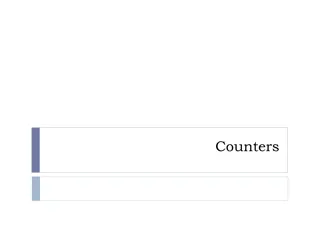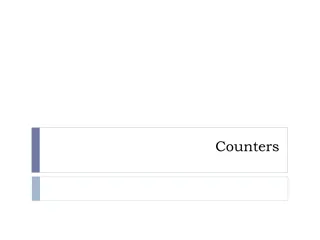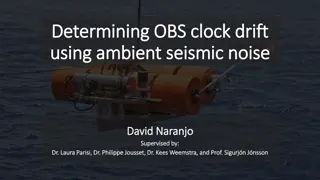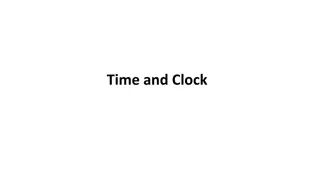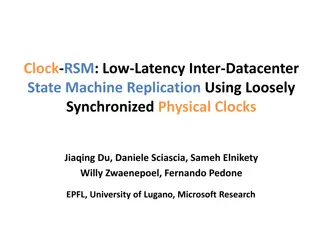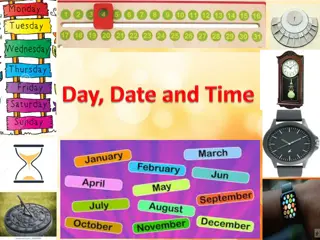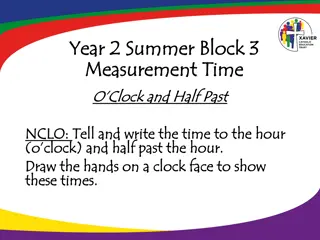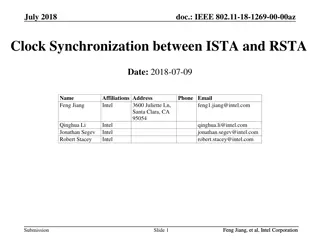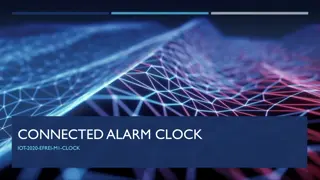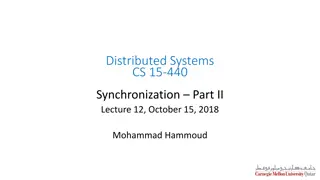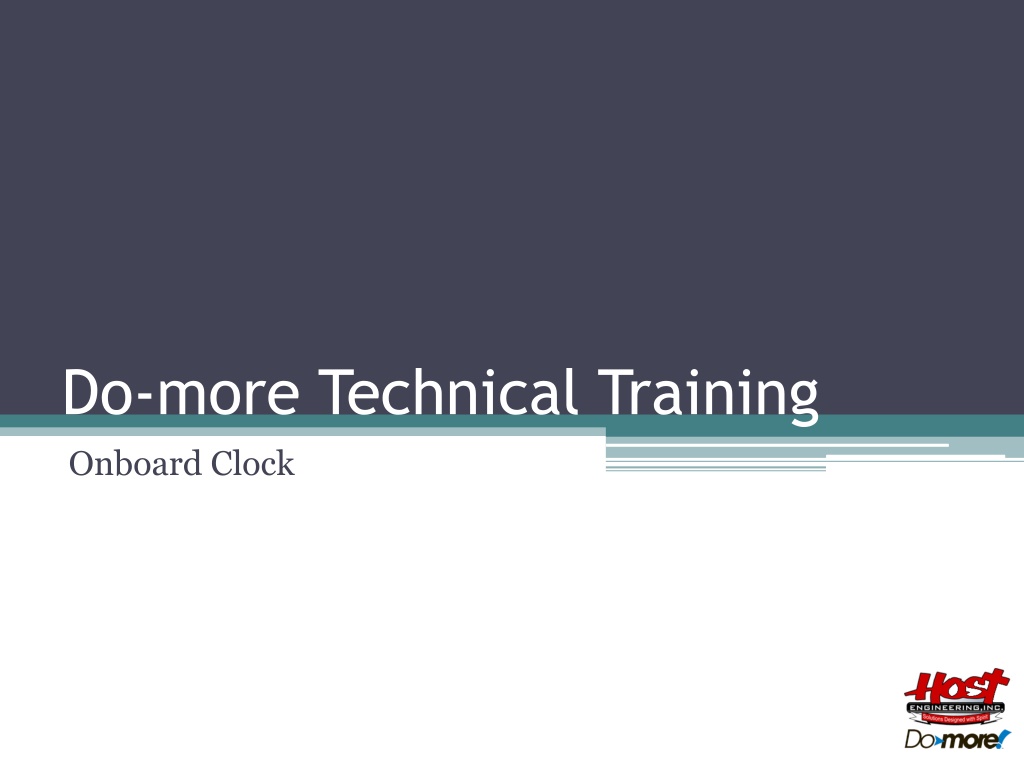
Technical Training: Onboard Clock System Overview
Learn about the onboard clock system accuracy, time storage methods, date/time structure, and setting options. Understand how to manually and automatically set the system clock for optimal performance and synchronization.
Download Presentation

Please find below an Image/Link to download the presentation.
The content on the website is provided AS IS for your information and personal use only. It may not be sold, licensed, or shared on other websites without obtaining consent from the author. If you encounter any issues during the download, it is possible that the publisher has removed the file from their server.
You are allowed to download the files provided on this website for personal or commercial use, subject to the condition that they are used lawfully. All files are the property of their respective owners.
The content on the website is provided AS IS for your information and personal use only. It may not be sold, licensed, or shared on other websites without obtaining consent from the author.
E N D
Presentation Transcript
Do-more Technical Training Onboard Clock
Onboard Clock Accuracy: 1.53 minutes/month Stored as UTC (Coordinated Universal Time) Stored in $UTC (DST21) Uses 1970 Epoch: number of seconds since 00:00:00, 01-January-1970 Adjusted by time zone $TimeZone (DST384) number of minutes Adjusted by Daylight Savings Time $SummerTime (ST768) ON +1 hour Adjusted time stored $LocalTime (DST22) UTC adjusted seconds NOTE: These values are not very useful Seconds 1970 Epoch
Onboard Clock $LocalTime (DST22) is also stored as Date/Time structure: $Now (SDT0) structure members: Year unsigned word Month unsigned byte Day unsigned byte DayOfWeek unsigned byte 0 = Sunday, 1 = Monday, etc. Hour unsigned byte Minute unsigned byte Second unsigned byte Date signed Dword YYYYMMDD (use Date Field to see) Time signed Dword DDHHMMSS (use Time Field so see) NOTE: Date& Time structure members are not very useful except for some HMI displays $SysShutdown (SDT1) date/time of last power OFF $SysStartup (SDT2) date/time of last power ON
Onboard Clock (The Basics) $UTC (DST21) 1,427,208,203 seconds 1970 Epoch $TimeZone (DST284) -300 minutes Minutes -18,000 seconds = 1,427,190,203 $SummerTime (ST768) Bit ON = +1 hour +3600 seconds = 1,427,193,803 $LocalTime (DST22) 1,427,193,803 seconds 1970 Epoch $Now.Year (2015) $Now.Month (3) $Now.Day (24) $Now.DayOfWeek (2) $Now.Hour (10) $Now.Minute (43) $Now.Second (23) Date/Time Structure $Now (SDT0)
Onboard Clock Setting the system clock: Manually: Set PLC Clock dialog Auomatically: (1) TimeSync function (2) NETTIME SNTP Client instruction (3) SETTIME Set PLC Date/Time instruction
Onboard Clock Manual Setting: PLC Set PLC Clock
Onboard Clock Automatic Setting: (1) TimeSync function: CPU Configuration TimeSync Configuration Client: Listens for server s time-sync packet If heard $TimeSynced (ST23) = ON Sets onboard clock $UTC (DST21) Keeps listening (times down from Update Interval) If Update Interval times out $TimeSynced (ST23) = OFF Keeps listening (times down from Update Interval) Server: transmits 3 time-sync packets (5 second intervals) every Update Interval) Alternate: Normally a Client If Update Interval times out + 15 seconds Becomes the new Server Update Interval: 0 32,767 minutes (22 days)
Onboard Clock Automatic Setting: (2) NETTIME SNTP Client instruction Retrieves date/time from an SNTP (Simple Network Time Protocol) Server & stored in $UTC (DST21) Parameters: Device onboard Ethernet port SNTP Server IP Address Fixed IP Address IP address of SNTP Server Variable IP Address (32-bit word) variable IP address of SNTP Server commonly obtained by DNSLOOKUP Name to IP Address instruction UDP Port Number SNTP Protocol default is 123 Network Timeout 1 to 65.535 seconds On Success, On Error Action to take Instruction is leading-edge triggered NOTE: NTP protocol is not supported
Onboard Clock Automatic Setting: (3) SETTIME Set PLC Date/Time instruction Writes date/time to system clock Writes $UTC (DST21) directly, or Writes $LocalTime (DST22) then back-adjusts $UTC (DST21) based on: $TimeZone (DST284) value $SummerTime (ST768) bit Parameters: Source Date/Time structure containing setting Source Type: Local Time Source Date/Time represents local time UTC Time Source Date/Time represents UTC time Instruction is leading-edge triggered (DST22) $UTC (DST21) $TimeZone (DST284) $SummerTime (ST768) $LocalTime $Now (SDT0)
Onboard Clock Programmatic use: Assignment: MEMCOPY Copy Memory Range MOVE Move Value Conversion: DT2EPOCH Convert Date/Time to 1970 Epoch EPOCH2DT Convert Epoch to Date/Time MATH NOW() function Get Date/Time as a 32-bit integer (1970 Epoch) Math-style operations: DTCMP Compare Date/Time DTDIFF Difference between two Date/Times DTOFFSET Add Offset to Date/Time
Onboard Clock Programmatic use: Assignment: MEMCOPY Copy Memory Range Use it to copy complete Date/Time structures
Onboard Clock Programmatic use: Assignment: MOVE Move Value Use it to copy single Date/Time structure members
Onboard Clock Programmatic use: Conversion: DT2EPOCH Convert Date/Time to 1970 Epoch Converts a Date/Time structure to 1970 Epoch value Parameters: Date/Time structure to convert 1970 Epoch location of converted value
Onboard Clock Programmatic use: Conversion: EPOCH2DT Convert Epoch to Date/Time Converts a 1970 Epoch value to Date/Time structure Parameters: 1970 Epoch seconds to convert Date/Time structure of converted value
Onboard Clock Programmatic use: Conversion: MATH Calculate Express NOW() function Converts the Date/Time structure $Now (SDT0) to 1970 Epoch value
Onboard Clock Programmatic use: Math-style operations: DTCMP Compare Date/Time Compares two Date/Time structures Parameters: First Date/Time 1st structure to be compared Second Date/Time 2nd structure to be compared Compare: Compare Date and Time Compare Date Only Compare Time Only Set if First Equals Second Set if First is Before Second Set if First is After Second
Onboard Clock Programmatic use: Math-style operations: DTDIFF Difference Between Two Date/Times Calculates the number of seconds of time between two Date/Time structures Parameters: Date/Time A Date/Time B Difference DTA-DTB in seconds
Onboard Clock Programmatic use: Math-style operations: DTOFFSET Add Offset to Date/Time Adds time to a Date/Time structure Parameters: Starting Date/Time Offset Constant will be normalized Negative Variable in seconds Ending Date/Time


